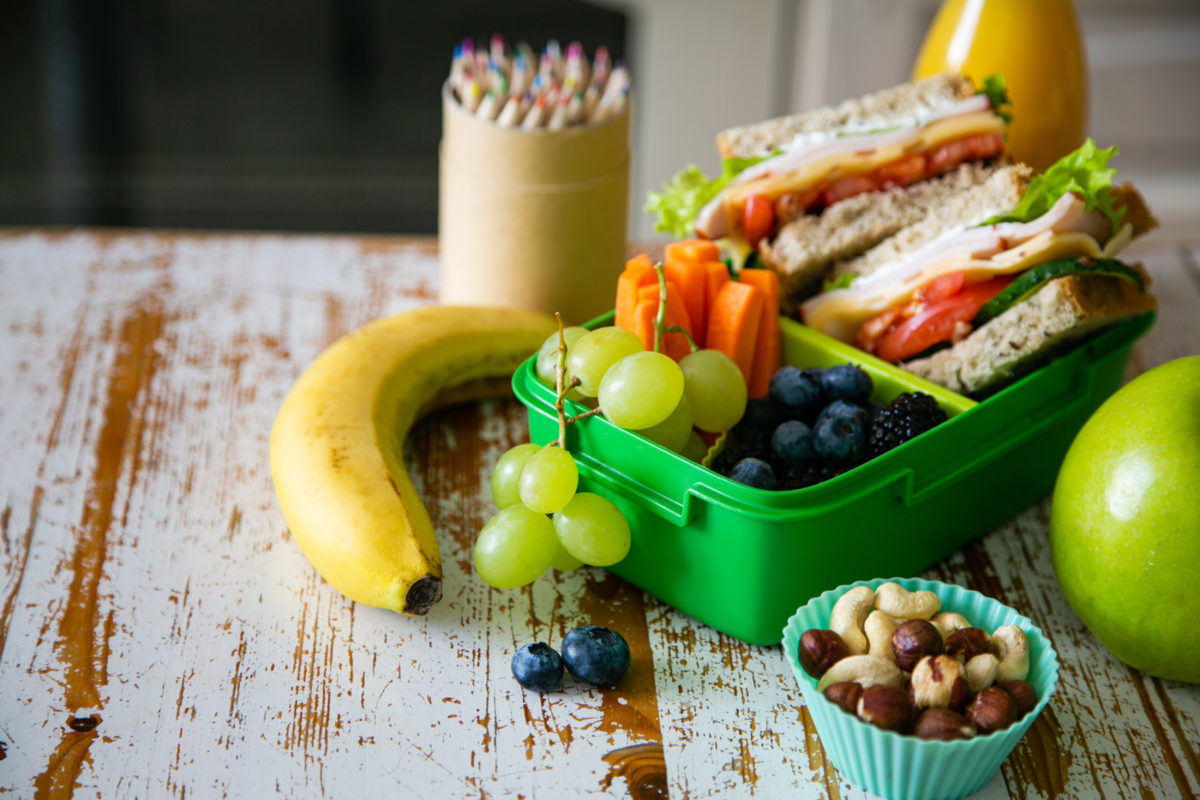School Lunchtime Q&A with Culinary Medicine Specialist Dr. Kerry Scott

When it comes to raising kids, time is of the essence, but there never seems to be enough of it. If your goal is to provide nutritious, healthy lunches that your family will love, Dr. Scott has some helpful recommendations!
How does a parent know what the calorie content of a daily lunch should be? How about for after-school sports?
The foods that children consume help to provide the energy they need to function productively throughout the day. The calorie content of a food item describes the amount of energy it provides.
The estimated total amount of daily calories that children need vary according to age, gender, and physical activity levels.
- Toddlers (2-3 years old) require total daily calorie intake in the range of 1000 calories-1400 calories
- Children (4-8 years old) require total daily calorie intake in the range of 1200 calories-1800 calories
- Children (9-13 years old) require total daily calorie intake in the range of 1600 calories-2600 calories
- Children (14-18 years old) require total daily calorie intake in the range of 1800 calories-3200 calories
When parents are planning meals for their children, they should consider the 3 basic meals (breakfast, lunch and dinner) as well as account for daily snacks. Dividing the total daily calories required by the number of meal times will provide parents with a simple guide when choosing foods to incorporate in to each meal.
For example: A 8-year-old male who is very active with soccer after school may require up to 1800 calories to provide enough energy to get him through the day. He eats the basic 3 meals plus a snack after school before soccer practice. When planning meals for him, he would need about 450 calories in each of his 4 meals.
What are some things that should be avoided that are typically perceived as healthy?
It is important to incorporate as many healthy food options into children’s meal plans as possible. Many children are picky eaters and enjoy snacks more than balanced meals. Processed snack items have been manufactured to taste good and marketed to appeal to children. Since these snacks have been processed, they are made with added sugars and salt to appeal to the taste buds. Added sugars can lead to weight gain and obesity, especially in children who are not physically active. The high salt (sodium) intake can lead to early hypertension in children.
Some examples of unhealthy snacks that should be avoided include:
- Packed fruit snacks/gummies
- Soda
- Fruit juice/boxed juices
- Sugary cereals
- Pop Tarts
- Packaged lunch box meals
- Flavored yogurt
- Energy bars and drinks
- Hot dogs
- Fast food
- Frozen chicken nuggets/dinners
- Boxed macaroni and cheese
- Chips
- Candy
How important is breakfast and what components should that meal include?
Breakfast is one of the most important meals of the day, especially for active, growing children. Breakfast sets the pace and provides the energy needed to get those brain cells working for the day. It is important to avoid excessive sugary food items such as sweetened cereals and fruit juices. Some healthier breakfast options include foods like oatmeal, cream of wheat with dried fruit or nuts, bananas, strawberries, blueberries, Greek yogurt, fruit smoothies, bagels, whole-grain toast, eggs, poultry, fish, apple, melon, and beans. With a little planning and creativity, exciting and healthy breakfasts will have the children up early and ready for school!
How much sugar is too much sugar?
A major health concern for children is obesity. The obesity rate for young children continues to increase each year and these children are at increased risk of developing chronic health conditions such as diabetes, heart disease, fatty liver disease and early degenerative joint disease. Children of all ages love sweet things and sugar is the reason. Not all sugar is bad, but sugar in excess is dangerous. Simple sugars are naturally occurring sugars found in fruits, vegetables, honey, and added sugars in candy, jams, jellies, etc. These sugars can cause spikes in blood sugar levels when eaten, increasing the risk over time to the development of insulin resistance and diabetes.
Complex sugars are found in beans, whole grain, oats, popcorn, and starchy vegetables. The sugars in these foods break down slowly and do not cause unwanted spikes in blood sugar levels. The American Heart Association recommends that children 2 years of age and older should limit sugar intake to no more than 6 teaspoons/ 25 grams/100 calories a day.
Are there any foods that encourage brain health and concentration?
The food we eat has the ability to improve health in many ways. Some foods even help with brain function and concentration which is vital to success in school. Some healthy foods that may help boost brain function and concentration include:
- Fatty fish (salmon, tuna, mackerel)- rich in Omega 3 fatty acids
- Blueberries – strong antioxidant prevents inflammation
- Broccoli – strong antioxidant, rich in Vitamin K
- Dark chocolate
- Eggs
- Nuts
Can you share some recipes for healthy lunches?
Health Meets Food offers plenty of ideas for healthier lunch options. Check them out here!
For more healthy recipes, visit Health Meets Food.

Dr. Scott is a Certified Culinary Medicine Specialist (CCMS) who uses a unique foundation for incorporating healthy eating into patients’ diets. He has a comprehensive knowledge of nutrition and culinary techniques to prepare food that is consistent with real-world budgets, time constraints, and nutritional ideals.
Dr. Scott is board certified in family medicine and Osteopathic Manipulative Treatment.
